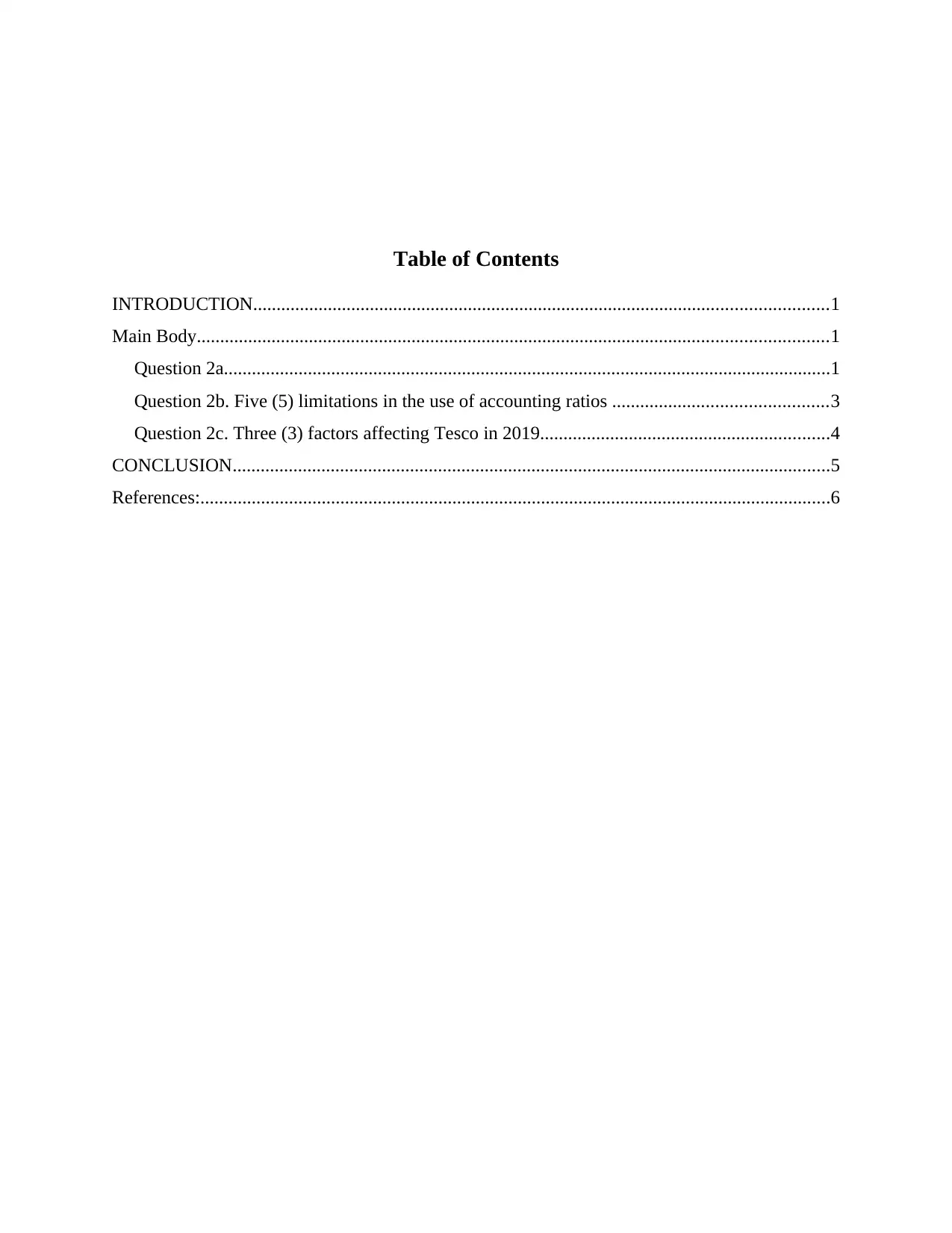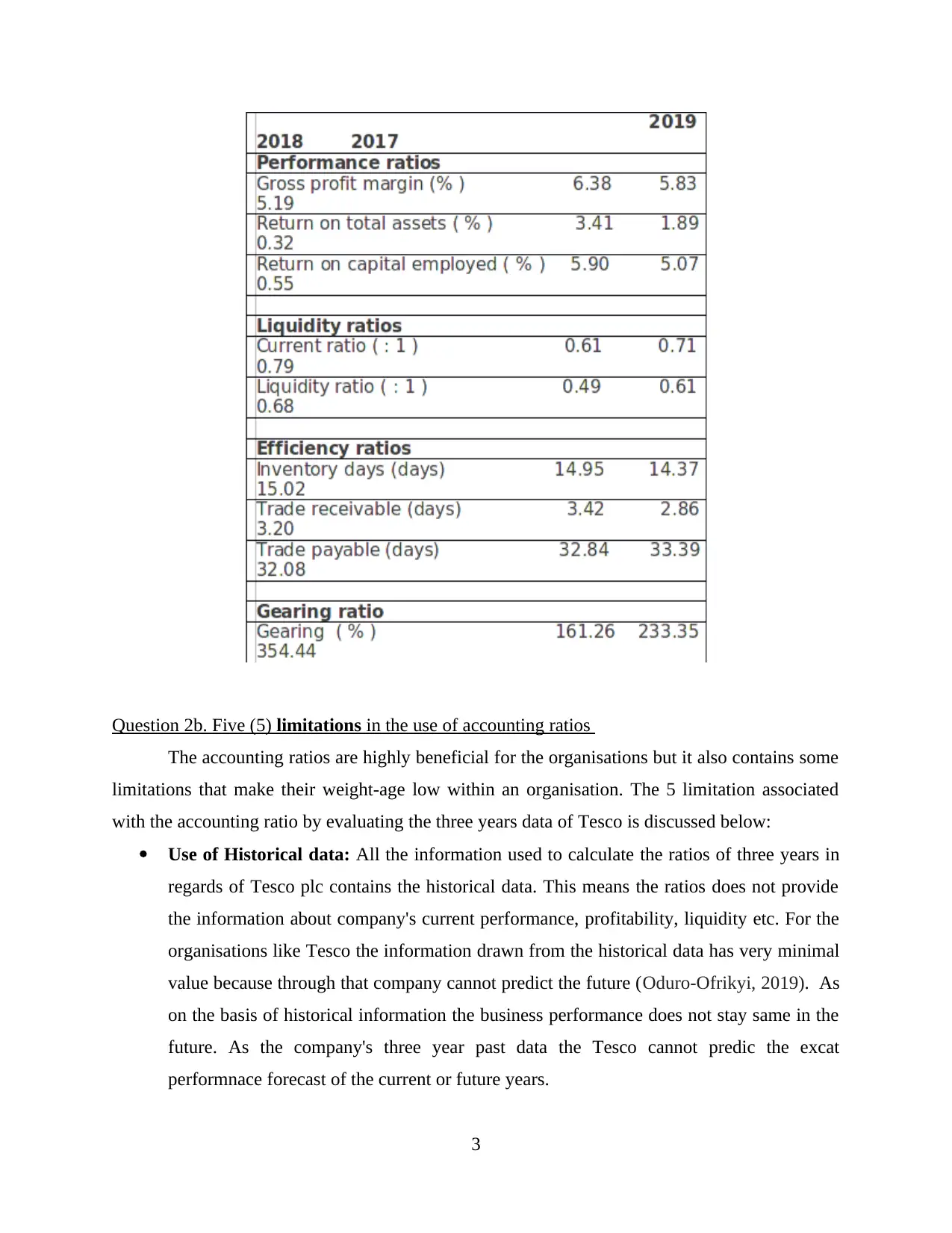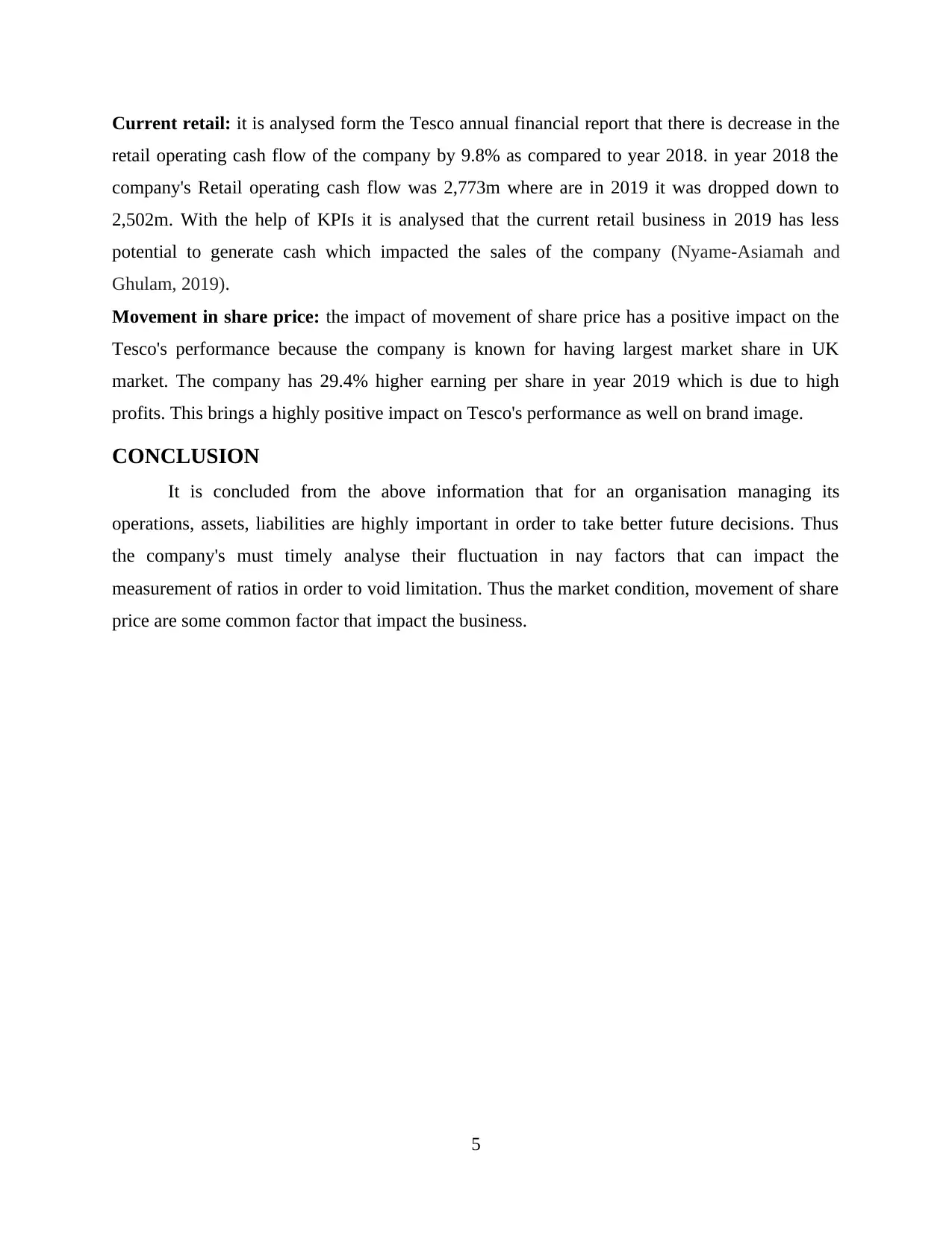Tesco PLC Financial Performance: Ratio Analysis and Key Factors
VerifiedAdded on 2023/06/18
|8
|2050
|90
Report
AI Summary
This report provides an analysis and evaluation of Tesco PLC's performance, liquidity, and financial structure over the three-year period from 2017 to 2019. It uses accounting ratios to explain the company's performance and position, highlighting the gross profit margin, return on total assets, return on capital employed, current ratio, liquidity ratio, inventory days, trade receivables days, trade payable ratio and gearing ratio. The report also discusses five limitations in the use of accounting ratios, including the use of historical data, inflationary effects, operational changes, manipulation of financial statements, and seasonal effects. Finally, it examines three factors affecting Tesco in 2019: market conditions, current retail performance, and movement in share price. Desklib is your go-to platform for accessing similar solved assignments and resources.

Business decision
making
making
Paraphrase This Document
Need a fresh take? Get an instant paraphrase of this document with our AI Paraphraser

Table of Contents
INTRODUCTION...........................................................................................................................1
Main Body.......................................................................................................................................1
Question 2a..................................................................................................................................1
Question 2b. Five (5) limitations in the use of accounting ratios ..............................................3
Question 2c. Three (3) factors affecting Tesco in 2019..............................................................4
CONCLUSION................................................................................................................................5
References:.......................................................................................................................................6
INTRODUCTION...........................................................................................................................1
Main Body.......................................................................................................................................1
Question 2a..................................................................................................................................1
Question 2b. Five (5) limitations in the use of accounting ratios ..............................................3
Question 2c. Three (3) factors affecting Tesco in 2019..............................................................4
CONCLUSION................................................................................................................................5
References:.......................................................................................................................................6

INTRODUCTION
In a business organisation to make the right financial decision there is requirement of the
adequate amount of right economic information. The right amount of correct financial
information of an organisation helps the managers of the company in determining the
performance, liquidity and financial health of the company. In order to analyse the company's
performance, profits, liquidity etc. (Greenberg and Hershfield, 2019) . the measurement and
analysis of the ratios is the best technique that company can use. The present report is based on
Tesco plc- a British multinational supermarket chain that has largest market share in UK. The
report will highlight Tesco Plc performance and position using the accounting ratios. Further the
limitation of the accounting ratios are analysed and evaluated for three years. In the end three
factors affecting Tesco plc performance in 2019 are discussed.
Main Body
Question 2a
The financial statements focuses on catering the financial information about the business
in order to make best financial and other decisions related to the company. The accounting ratio's
are the part of the financial statements and are considered as the crucial tool to analyse the worth
of company's operations through its financial statements. Tesco plc is one of the most well
known multinational supermarket store. The financial ratio or accounting ratios of the company
for the period of three years is analysed and evaluated below:
The gross profit margin is the financial metric that indicates the efficiency of the Tesco
plc in managing its daily and production operations (Greenberg and Hershfield, 2019) . By
comparing the gross profit margin of Tesco plc of three years it is recognised that in year 2019
company has higher efficiency and proficiency in managing its production process compared to
the year 2018 and 2017. In year 2017 and 2019 the there is the reduced gross profit which
signifies that Tesco plc is not producing their product with efficiency in the last two years
compared to year 2019 and this is due to reduction in sales of the company and due to poor
pricing techniques. The Return on total asset ratio calculates the net income generated by the
Tesco from its assets. By comparing Return on total assets ratio of the three years of Tesco plc it
is recognised that the company in 2017 has very low return on total assets as Tesco was not able
to utilize its assets or resources optimally due to which profits where lower but in upcoming
1
In a business organisation to make the right financial decision there is requirement of the
adequate amount of right economic information. The right amount of correct financial
information of an organisation helps the managers of the company in determining the
performance, liquidity and financial health of the company. In order to analyse the company's
performance, profits, liquidity etc. (Greenberg and Hershfield, 2019) . the measurement and
analysis of the ratios is the best technique that company can use. The present report is based on
Tesco plc- a British multinational supermarket chain that has largest market share in UK. The
report will highlight Tesco Plc performance and position using the accounting ratios. Further the
limitation of the accounting ratios are analysed and evaluated for three years. In the end three
factors affecting Tesco plc performance in 2019 are discussed.
Main Body
Question 2a
The financial statements focuses on catering the financial information about the business
in order to make best financial and other decisions related to the company. The accounting ratio's
are the part of the financial statements and are considered as the crucial tool to analyse the worth
of company's operations through its financial statements. Tesco plc is one of the most well
known multinational supermarket store. The financial ratio or accounting ratios of the company
for the period of three years is analysed and evaluated below:
The gross profit margin is the financial metric that indicates the efficiency of the Tesco
plc in managing its daily and production operations (Greenberg and Hershfield, 2019) . By
comparing the gross profit margin of Tesco plc of three years it is recognised that in year 2019
company has higher efficiency and proficiency in managing its production process compared to
the year 2018 and 2017. In year 2017 and 2019 the there is the reduced gross profit which
signifies that Tesco plc is not producing their product with efficiency in the last two years
compared to year 2019 and this is due to reduction in sales of the company and due to poor
pricing techniques. The Return on total asset ratio calculates the net income generated by the
Tesco from its assets. By comparing Return on total assets ratio of the three years of Tesco plc it
is recognised that the company in 2017 has very low return on total assets as Tesco was not able
to utilize its assets or resources optimally due to which profits where lower but in upcoming
1
⊘ This is a preview!⊘
Do you want full access?
Subscribe today to unlock all pages.

Trusted by 1+ million students worldwide

years i.e. 2018 and 2019 there was increase in ratio as the company was able to improve its
techniques and strategies to utilize and manage the resources in order to generate better profits.
Return on capital employed is the ratio that exhibits the amount of profitability in respect of
company's invested capital. As per the table the company has highest return on capital in year
2019 which means company is gaining higher return on its invested capital in comparison of
other two years. After analysing the above ratios it is analysed the Tesco plc is performing very
efficiently and effectively in year 2019 as compared to past two years. By analysing the two
liquidity ratios of the Tesco plc that is current ratio and liquidity ratio liquidity of the Tesco plc is
analysed. By analysing current ratio it was predicted that company does not have enough assets
to pay its liabilities as the ratios measured are all lower than 1. This calculation symbolizes the
unfavourable condition for the Tesco plc. Through liquidity ratio it is interpreted that Tesco plc
is working under thin liquidity cushion which means company must focus on increasing its assets
in order to avoid financial crisis ion future. The efficiency ratio are useful to company in
understanding how efficient the company is managing its inventory, sales, transactions etc. By
analysing the inventory days ratio it is recognised that the Tesco Plc has increased its efficiency
in year 2019 as number of days are reduced compared to year 2017. This means company is able
to sell its inventory in 14. 95 days (Sukandani and et. al., 2021). After analysing the trade
receivables days of the Tesco plc it is analysed that there is increase in the trade debtors as the
company has increase of days in year 2019 which is approximately similar to year 2017. The
trade payable ratio of the Tesco plc does not have much change in past three years as the
company is regularly paying all its suppliers in the particular specified time. Gearing Ratio helps
in organisation like Tesco to get an insight about the funds its operations related to the debt and
equity. Basically means that using this ratio the company compare its debts with the other
financial metrics such as equity and assets (Biancone, Secinaro and Brescia, 2017). By
comparing Ratio of 3 years of Tesco it is analysed in 2019 company is at very low risk of
financial long-term investors lenders in other parties are by analysing the documents of the
company which states good financial stability and an opportunity to expand in new market.
2
techniques and strategies to utilize and manage the resources in order to generate better profits.
Return on capital employed is the ratio that exhibits the amount of profitability in respect of
company's invested capital. As per the table the company has highest return on capital in year
2019 which means company is gaining higher return on its invested capital in comparison of
other two years. After analysing the above ratios it is analysed the Tesco plc is performing very
efficiently and effectively in year 2019 as compared to past two years. By analysing the two
liquidity ratios of the Tesco plc that is current ratio and liquidity ratio liquidity of the Tesco plc is
analysed. By analysing current ratio it was predicted that company does not have enough assets
to pay its liabilities as the ratios measured are all lower than 1. This calculation symbolizes the
unfavourable condition for the Tesco plc. Through liquidity ratio it is interpreted that Tesco plc
is working under thin liquidity cushion which means company must focus on increasing its assets
in order to avoid financial crisis ion future. The efficiency ratio are useful to company in
understanding how efficient the company is managing its inventory, sales, transactions etc. By
analysing the inventory days ratio it is recognised that the Tesco Plc has increased its efficiency
in year 2019 as number of days are reduced compared to year 2017. This means company is able
to sell its inventory in 14. 95 days (Sukandani and et. al., 2021). After analysing the trade
receivables days of the Tesco plc it is analysed that there is increase in the trade debtors as the
company has increase of days in year 2019 which is approximately similar to year 2017. The
trade payable ratio of the Tesco plc does not have much change in past three years as the
company is regularly paying all its suppliers in the particular specified time. Gearing Ratio helps
in organisation like Tesco to get an insight about the funds its operations related to the debt and
equity. Basically means that using this ratio the company compare its debts with the other
financial metrics such as equity and assets (Biancone, Secinaro and Brescia, 2017). By
comparing Ratio of 3 years of Tesco it is analysed in 2019 company is at very low risk of
financial long-term investors lenders in other parties are by analysing the documents of the
company which states good financial stability and an opportunity to expand in new market.
2
Paraphrase This Document
Need a fresh take? Get an instant paraphrase of this document with our AI Paraphraser

Question 2b. Five (5) limitations in the use of accounting ratios
The accounting ratios are highly beneficial for the organisations but it also contains some
limitations that make their weight-age low within an organisation. The 5 limitation associated
with the accounting ratio by evaluating the three years data of Tesco is discussed below:
Use of Historical data: All the information used to calculate the ratios of three years in
regards of Tesco plc contains the historical data. This means the ratios does not provide
the information about company's current performance, profitability, liquidity etc. For the
organisations like Tesco the information drawn from the historical data has very minimal
value because through that company cannot predict the future (Oduro-Ofrikyi, 2019). As
on the basis of historical information the business performance does not stay same in the
future. As the company's three year past data the Tesco cannot predic the excat
performnace forecast of the current or future years.
3
The accounting ratios are highly beneficial for the organisations but it also contains some
limitations that make their weight-age low within an organisation. The 5 limitation associated
with the accounting ratio by evaluating the three years data of Tesco is discussed below:
Use of Historical data: All the information used to calculate the ratios of three years in
regards of Tesco plc contains the historical data. This means the ratios does not provide
the information about company's current performance, profitability, liquidity etc. For the
organisations like Tesco the information drawn from the historical data has very minimal
value because through that company cannot predict the future (Oduro-Ofrikyi, 2019). As
on the basis of historical information the business performance does not stay same in the
future. As the company's three year past data the Tesco cannot predic the excat
performnace forecast of the current or future years.
3

Inflationary effects: from the above evaluation it is analysed that the ratios of the Tesco
for the three years are deprived of the change in the prices of market share (Ahmed,
2021). In 2019 the Tesco has huge fluctuation in its market share price but that doesn't
showcased in the ratios. Because the financial statements are released in every quarter
during which inflation occurred is not recorded and the real prices are not reflected in the
report. Due to this accounting ratios holds an limitation of imperfection as there is no
adjustments of the inflation prices.
Operational changes: as per the ratio measured for year 2017, 2018 and 2019 the
company has misleading performance in past years. Because the Tesco has changed its
operational structure in some year such change in their supply chain strategy and change
in the product they are selling. Thus this operational changes is the big limitation to the
accounting ratio of the Tesco as they are not recorded in financial statements that
misleads the company's performance and future growth ad opportunities (Al-Suraihi and
et. al., 2020).
Manipulation of financial statements: the accounting ratios are calculated using the
information recorded and audited in the financial reports and statements of the Tesco.
This brings a major limitation as the management of Tesco can modify or manipulate the
information in order to demonstrate the better performance of the company in market for
better market share.
Seasonal effects: Tesco operates under the retail industry where there are seasonal
changes in the supplies that fluctuate the prices, suppliers cost etc. The financial analyst
of the Tesco plc are aware that seasonal factors mislead the calculation and measurement
of the ratios. Therefore the inability to reconsolidated the financial ratio effects or lead to
false interpretation of the company's performance for future.
Question 2c. Three (3) factors affecting Tesco in 2019
There are many factors that impact the performance of an organisation. In case of Tesco plc the
three factors that has impacted the company's performance in 2019 are discussed below :
Market condition: When operating in retail counters the market plays a huge importance. The
UK market condition in year 2019 was bit tight as the there was emergence of Covid-19. The
market was also full of competition that impacted the business of Tesco as the strategies of other
competitor's were tough enough to conquer the profits of TESCO.
4
for the three years are deprived of the change in the prices of market share (Ahmed,
2021). In 2019 the Tesco has huge fluctuation in its market share price but that doesn't
showcased in the ratios. Because the financial statements are released in every quarter
during which inflation occurred is not recorded and the real prices are not reflected in the
report. Due to this accounting ratios holds an limitation of imperfection as there is no
adjustments of the inflation prices.
Operational changes: as per the ratio measured for year 2017, 2018 and 2019 the
company has misleading performance in past years. Because the Tesco has changed its
operational structure in some year such change in their supply chain strategy and change
in the product they are selling. Thus this operational changes is the big limitation to the
accounting ratio of the Tesco as they are not recorded in financial statements that
misleads the company's performance and future growth ad opportunities (Al-Suraihi and
et. al., 2020).
Manipulation of financial statements: the accounting ratios are calculated using the
information recorded and audited in the financial reports and statements of the Tesco.
This brings a major limitation as the management of Tesco can modify or manipulate the
information in order to demonstrate the better performance of the company in market for
better market share.
Seasonal effects: Tesco operates under the retail industry where there are seasonal
changes in the supplies that fluctuate the prices, suppliers cost etc. The financial analyst
of the Tesco plc are aware that seasonal factors mislead the calculation and measurement
of the ratios. Therefore the inability to reconsolidated the financial ratio effects or lead to
false interpretation of the company's performance for future.
Question 2c. Three (3) factors affecting Tesco in 2019
There are many factors that impact the performance of an organisation. In case of Tesco plc the
three factors that has impacted the company's performance in 2019 are discussed below :
Market condition: When operating in retail counters the market plays a huge importance. The
UK market condition in year 2019 was bit tight as the there was emergence of Covid-19. The
market was also full of competition that impacted the business of Tesco as the strategies of other
competitor's were tough enough to conquer the profits of TESCO.
4
⊘ This is a preview!⊘
Do you want full access?
Subscribe today to unlock all pages.

Trusted by 1+ million students worldwide

Current retail: it is analysed form the Tesco annual financial report that there is decrease in the
retail operating cash flow of the company by 9.8% as compared to year 2018. in year 2018 the
company's Retail operating cash flow was 2,773m where are in 2019 it was dropped down to
2,502m. With the help of KPIs it is analysed that the current retail business in 2019 has less
potential to generate cash which impacted the sales of the company (Nyame-Asiamah and
Ghulam, 2019).
Movement in share price: the impact of movement of share price has a positive impact on the
Tesco's performance because the company is known for having largest market share in UK
market. The company has 29.4% higher earning per share in year 2019 which is due to high
profits. This brings a highly positive impact on Tesco's performance as well on brand image.
CONCLUSION
It is concluded from the above information that for an organisation managing its
operations, assets, liabilities are highly important in order to take better future decisions. Thus
the company's must timely analyse their fluctuation in nay factors that can impact the
measurement of ratios in order to void limitation. Thus the market condition, movement of share
price are some common factor that impact the business.
5
retail operating cash flow of the company by 9.8% as compared to year 2018. in year 2018 the
company's Retail operating cash flow was 2,773m where are in 2019 it was dropped down to
2,502m. With the help of KPIs it is analysed that the current retail business in 2019 has less
potential to generate cash which impacted the sales of the company (Nyame-Asiamah and
Ghulam, 2019).
Movement in share price: the impact of movement of share price has a positive impact on the
Tesco's performance because the company is known for having largest market share in UK
market. The company has 29.4% higher earning per share in year 2019 which is due to high
profits. This brings a highly positive impact on Tesco's performance as well on brand image.
CONCLUSION
It is concluded from the above information that for an organisation managing its
operations, assets, liabilities are highly important in order to take better future decisions. Thus
the company's must timely analyse their fluctuation in nay factors that can impact the
measurement of ratios in order to void limitation. Thus the market condition, movement of share
price are some common factor that impact the business.
5
Paraphrase This Document
Need a fresh take? Get an instant paraphrase of this document with our AI Paraphraser

References:
Books and Journals
Ahmed, A.A.A., 2021. Corporate attributes and disclosure of accounting information: Evidence
from the big five banks of China. Journal of Public Affairs. 21(3). p.e2244.
Al-Suraihi, W.A and et. al., 2020. The Effect of Customer Relationship Management on
Consumer Behavior: A Case of Retail Industry in Malaysia. International Journal of
Management and Human Science (IJMHS). 4(3). pp.32-40.
Biancone, P., Secinaro, S. and Brescia, V., 2017. Golden Ratio Accounting. The evidence in
Financial Reporting.
Greenberg, A.E. and Hershfield, H.E., 2019. Financial decision making. Consumer Psychology
Review. 2(1). pp.17-29.
Nyame-Asiamah, F. and Ghulam, S., 2019. The relationship between CSR activity and sales
growth in the UK retailing sector. Social Responsibility Journal.
Oduro-Ofrikyi, C., 2019. Assessing the financial performance of GCB bank using accounting
ratios,(2006-2015) (Doctoral dissertation, University of Education, Winneba).
Sukandani, Y and et. al., 2021. THE ROLE OF ACCOUNTING CONSERVATISM AS A
MODERATE OF DEBT RATIO EFFECT ON FINANCIAL DISTRESS. International
Journal of Economics, Business and Accounting Research (IJEBAR), 5(2).
6
Books and Journals
Ahmed, A.A.A., 2021. Corporate attributes and disclosure of accounting information: Evidence
from the big five banks of China. Journal of Public Affairs. 21(3). p.e2244.
Al-Suraihi, W.A and et. al., 2020. The Effect of Customer Relationship Management on
Consumer Behavior: A Case of Retail Industry in Malaysia. International Journal of
Management and Human Science (IJMHS). 4(3). pp.32-40.
Biancone, P., Secinaro, S. and Brescia, V., 2017. Golden Ratio Accounting. The evidence in
Financial Reporting.
Greenberg, A.E. and Hershfield, H.E., 2019. Financial decision making. Consumer Psychology
Review. 2(1). pp.17-29.
Nyame-Asiamah, F. and Ghulam, S., 2019. The relationship between CSR activity and sales
growth in the UK retailing sector. Social Responsibility Journal.
Oduro-Ofrikyi, C., 2019. Assessing the financial performance of GCB bank using accounting
ratios,(2006-2015) (Doctoral dissertation, University of Education, Winneba).
Sukandani, Y and et. al., 2021. THE ROLE OF ACCOUNTING CONSERVATISM AS A
MODERATE OF DEBT RATIO EFFECT ON FINANCIAL DISTRESS. International
Journal of Economics, Business and Accounting Research (IJEBAR), 5(2).
6
1 out of 8
Related Documents
Your All-in-One AI-Powered Toolkit for Academic Success.
+13062052269
info@desklib.com
Available 24*7 on WhatsApp / Email
![[object Object]](/_next/static/media/star-bottom.7253800d.svg)
Unlock your academic potential
Copyright © 2020–2025 A2Z Services. All Rights Reserved. Developed and managed by ZUCOL.





